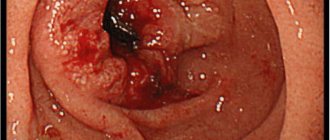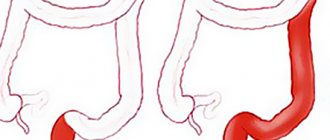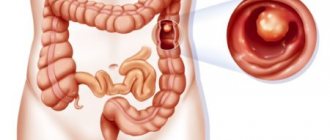Neoplasm affecting the colon
The most common type is moderately differentiated adenocarcinoma of the colon. Therefore, treatment should begin at all stages of it. This disease is understood as a malignant tumor, which is the fourth most common. In this case, new tissues are formed, involving glandular cells with serous filling. There are cases when the tumor spread to the abdominal cavity, passing through the intestines.
A characteristic feature of how differentiated colon adenocarcinoma proceeds is the reason for the high mortality rate from this disease, since late diagnosis is likely.
This type of cancer accounts for eighty percent of intestinal damage, most often affecting the cecum. Men get sick more often than women, and in the latter the incidence of the disease comes after cancer of the stomach, lungs, and breasts. If you are over fifty years old, you should undergo an examination and preferably do this regularly.
Attention: the risk of the disease is higher in older people and in retirement. The disease is directly related to the size of the cells, their depth, whether there are metastases, and how widespread it is.
Since the disease has few symptoms, such problems are often ignored, and it is difficult to identify such a disease, because the patient practically does not feel any problems in the body.
Classification of the disease - main differences
There are a variety of possibilities for the distribution of the disease. Let's pay attention to how normal and diseased cells differentiate. There are three types of colon adenocarcinoma. This is about:
- highly differentiated;
- moderately differentiated;
- poorly differentiated.
The cancer is spread over a small surface, there are very few cells, so the disease process proceeds calmly and without the risk of death. Well-differentiated colon adenocarcinoma can be said to have the most favorable prognosis.
Well-differentiated adenocarcinoma of the colon passes without complications, the tumors are slightly enlarged. At first glance, they look like unaffected cells, so they can work, performing the function of this organ.
Usually the outcome is always favorable, even older people live long, because... Cancer cells do not form in other organs. People live at least 5 years 50 percent of the time if they are over fifty.
If a young person gets sick, then the reappearance of cells is high. Therefore, if cancer cells were discovered in him, then he is being seriously monitored. Since only forty percent of people can survive 5 years in their youth or fully recover.
This type of cancer ranks fourth among cancer tumors that have serious consequences. Neoplasms fill the organ so much that intestinal obstruction begins, which is usually the reason for the patient to contact a specialist.
There is also a danger that large tumor lumps rupture the walls of the organ, and this causes internal bleeding, filling the stomach cavity with body waste. There is also a danger in the appearance of holes. Peritonitis develops, as already mentioned, which worsens the prognosis of the disease.
Therefore, moderately differentiated colon adenocarcinoma does not have the most favorable prognosis for patients with this disease, since moderately differentiated colon adenocarcinoma changes stages easily and can quickly reach the last stage. It is for this reason that the disease must be treated urgently. Remission is only possible with an integrated approach when the tumor is still at an early stage.
Only thirty percent can live with a tumor for five years, and if it’s stage three, then they can barely survive fifteen. Therefore, everything has to do with how quickly treatment began, how quickly tumors were identified and, if possible, removed.
Poorly differentiated adenocarcinoma of the colon is detected in twenty percent of patients, as it can behave aggressively and has brightly infected epithelia. They grow at high speed, they have a high degree of metastases, even if the cancer has just been discovered.
Poorly differentiated colon adenocarcinoma, when compared with the first type, has a not very specific prognosis, since these cells do not have clear outlines, they are difficult to remove, and they metastasize very often. Since the surgical method is useless, the patient is treated symptomatically, especially since the outcome is a foregone conclusion.
Prevention
Compliance with preventive measures can reduce the risk factor for recurrence of the disease:
- exercise regularly;
- consumption of fermented milk products, ingredients rich in plant fiber;
- compliance with the drinking regime;
- avoiding stress;
- refusal to use tobacco and alcohol products;
- fractional meals;
- regular comprehensive examination.
With timely detection of tumors in the early stages, successful recovery is guaranteed in more than 90% of patients. In the presence of a large tumor and metastatic spread, the prognosis for recovery is no more than 10% within 5 years.
We recommend: The most effective folk remedies for the treatment of intestinal colitis
Course of the disease and organ damage
Colon adenocarcinoma can metastasize to nearby organs, and metastasis to distant and lymph nodes is also possible. There are three ways of metastasis:
- lymphogenicity, which occurs in sixty percent of cases;
- hematogenousness, characterizing ten percent of those coming;
- implantation, when the affected area comes into contact with healthy cells - the remaining thirty percent falls on these patients.
Usually the liver and regional lymph nodes are affected, less often it reaches the lungs and pelvic bones, since metastases may not spread to distant tissues.
Treatment of glandular tumors
For colon adenocarcinoma, complex treatment is practiced, including radical excision of the tumor within healthy tissue, removal of metastases, chemotherapy and radiation.
Please note: preoperative preparation includes cleansing enemas and the appointment of the so-called. “slag-free” diet and laxatives.
The affected part of the intestine is subject to resection with the formation of an anastomosis (anastomosis), restoring the integrity of the part of the digestive tract . If radical intervention is not possible, a colostomy is indicated to drain waste products.
In the postoperative period, patients are subject to mandatory clinical observation. They need to undergo regular tests and endoscopic examination of the lower gastrointestinal tract. An ultrasound examination is performed once every six months to detect possible metastases.
The combination of chemotherapy and radiotherapy as an independent treatment method is practiced for inoperable tumors. Its task is a general temporary improvement in the patient’s condition and a reduction in the level of general intoxication of the body.
Palliative treatment involves the prescription of potent (including narcotic) analgesics.
Plisov Vladimir, medical observer
20, total, today
( 195 votes, average: 4.76 out of 5)
Astrocytoma: symptoms and treatment
Hemorrhoids: symptoms, stages, treatment at home
Related Posts
Complications - how they manifest themselves
Since this is a complex disease, it leads to a large number of serious complications. We can talk about the following:
- obstruction - forty percent suffer from it, since the neoplasm blocks the intestine;
- rupture or perforation of the membrane, which leads to bleeding inside the abdominal cavity;
- cancer cells form where they come into contact;
- the appearance of interorgan holes, for example, they appear in the genitourinary system or in the prostate, and effusion into the abdominal cavity also occurs;
- the cancer cells themselves become covered with ulcers;
- restructuring of an organ, when one part of the organ is inserted into another;
- changes on the left side as stool accumulates to form ribbon-shaped stools.
Diagnostic methods
If you have symptoms of sigmoid colon cancer, you should contact a colonoproctologist. When carrying out diagnostics, a complex of laboratory and instrumental studies is used. The diagnosis is made based on:
- Survey.
- Objective examination. It includes examination of the skin and mucous membranes.
- Physical examination.
- Colonoscopy (examination of the colon using a special device).
- Sigmoidoscopy. Upon examination, a neoplasm is detected growing into the lumen of the sigmoid colon. The exact location and size of the tumor are determined. This is one of the most informative diagnostic methods.
- FEGDS. It is carried out to exclude pathologies of the stomach and duodenum.
- Ultrasound. Required to assess the condition of other abdominal organs (liver, gall bladder, pancreas, spleen, genitourinary organs).
- X-rays.
- CT and MRI.
- Biopsies with cytological and histological analyses.
- Irrigoscopy. Allows you to assess the patency and condition of the large intestine. The procedure is carried out after the introduction of a barium suspension. In a healthy person, the intestine stretches evenly and the contrast is well distributed along the wall of the sigmoid colon. In adenocarcinoma, a filling defect is detected.
- General clinical tests.
- Fecal occult blood test.
- Tests for tumor markers.
- Biochemical research.
The doctor must exclude other diseases (spastic intestinal obstruction, helminthiases, inflammatory diseases, benign tumors, polyps). For adenocarcinoma of the sigmoid colon, the prognosis depends on the timeliness of therapy and the presence of metastases. Surgery in the second and first stages improves the prognosis. At stage I, the five-year survival rate exceeds 90%, at stage II it is 82%. For stage III and IV cancer, this figure is 59% and 8%, respectively.
Diagnosis of the disease
There is a type of adenocarcinoma called mucinous. This is a kind of cancer that manifests itself in rectovaginal and perirectal fistula. For mucinous adenocarcinoma of the colon, the prognosis after surgery is usually positive. Surgery is done after a biopsy is taken, removing a whole range of mucus.
Consultation with an Israeli specialist
The tumors in this case are small, so surgery is definitely indicated for patients. After the operation, the intestines return to normal. Usually everything is represented mainly by mucus. The prognosis in this case is less favorable, so surgery is indicated, otherwise relapses and the formation of cancer cells in other parts of the body are possible.
It turns out that mucinous adenocarcinoma of the colon is the most dangerous differentiated adenocarcinoma of the colon. After all, then the mucus blocks the entire intestinal space, which leads to constipation. In addition, there is still a danger of severe metastasis.
Various methods are used to identify the disease
Mucinous adenocarcinoma or also dark cell adenocarcinoma of the colon is represented by individual fibers in the form of mucus, forming into small balls and floating along the channel, meeting other similar balls and connecting with them. This is very dangerous as it can rupture the organ. In this case, the prognosis is not encouraging.
Etiology of adenocarcinoma of the sigmoid colon
The exact causes of the development of adenocarcinoma of the sigmoid colon have not yet been fully established. It is believed that the main role in the appearance of formation is played by carcinogens and other harmful substances that enter the body with food and affect the intestines. The sigmoid colon is S-shaped. In this part of the intestine, stool acquires a thicker consistency, so the mucous membrane begins to come into contact with harmful substances. This is what triggers the formation of a tumor. Among other things, predisposing factors for the development of adenocarcinoma of the sigmoid colon include:
- age-related changes;
- metabolic disorders;
- alcohol abuse;
- smoking;
- work in hazardous industries;
- sedentary lifestyle.
Studies have shown that older adults who lead a healthy lifestyle, including daily exercise and eating a high-fiber diet, are extremely unlikely to develop adenocarcinoma of the sigmoid colon.
Glandular cancer
This type of cancer is divided into four types. Here's how it's presented:
| Mutationous | In this case, the tumor has no defined boundaries. Metastases pass to the lymphatic system. Radiotherapy does not work, so relapse rates are high |
| Cricoid cell | In this case, there is high aggression in its course. If a person becomes ill and consults a doctor, then usually there are metastases in the lymph and liver. Usually young people suffer from this disease, in this case the entire organ suffers. |
| Squamous | This tumor forms in the anus and consists of flat epithelial cells. In this case, people live up to three years; no more than thirty percent live to five. This happens due to the high mortality rate in this type of disease, because the disease has a high rate of relapse |
| Tubularity | In this case, the presence of tubular structures of the tumor leads to the fact that although the contours are blurred and the formations themselves are small, after surgery patients feel better in fifty percent of cases |
Causes
This pathology is considered multifactorial, that is, it is very difficult to single out one cause leading to its development.
Instead, there is a whole list of risk factors that can increase the likelihood of developing this cancer. The latter include:
- Chronic diseases of the sigmoid colon , such as polyposis, Crohn's disease, ulcerative colitis.
- Poor nutrition with a predominance of large amounts of fatty foods in the diet.
- abuse and smoking.
- Exposure to radioactive radiation .
- Consumption of products containing large amounts of genetically modified substances and chemical components.
Causes of the disease
Colon adenocarcinoma g1 is called a polyetiological disease. It develops for the following reasons:
- Genetic predisposition;
- Transformation into benign cells into cancer cells;
- The entire organ becomes ill;
- Presence of papillomaviruses;
- Obstruction that lasts a long time;
- Stressful state;
- Working while sitting;
- Sex in the anus;
- In older people;
- Due to an unhealthy lifestyle;
- With long-term use of asbestos;
- Medications containing toxins and various types of chemicals;
- Lack of fruits and vegetables in food, consisting only of baked goods, flour, meat, and fatty foods.
Causes of the disease
Doctors cannot say what is the reason for the degeneration of organ cells. But during observations, a number of factors were identified that become an impetus for the development of cancer:
- Disease of the sigmoid colon, which resulted in complications in the form of cancer.
- Violation of the diet and passion for fatty, sour or peppery foods, frequent consumption of alcohol.
- Genetic predisposition.
- Sedentary, sedentary lifestyle.
- The effects of radiation on the body.
- Frequent constipation. The hardened masses exert pressure on the muscles of the sigmoid colon, located longitudinally and transversely.
- Drug abuse.
In addition, age influences the development of cancer. So, over time, the intestinal muscles lose tone and cannot effectively cope with functions. This leads to stagnation of feces in the intestines. One of the factors is the type of human activity. According to statistics, people who work with wood or asbestos are more likely to develop adenocarcinoma of the sigmoid colon.
When sick, the following complaints
Surgery is the main treatment for bowel cancer
Moderately differentiated colon adenocarcinoma g2 does not always cause pain, but the person complains of:
- Acuteness of the abdomen, which may occur periodically;
- When you don't feel like eating;
- Constantly feeling nauseous;
- Severe unexplained fatigue;
- Constant constipation mixed with diarrhea;
- Strong release of gases;
- There is a lot of mucus and blood during bowel movements - this happens to ninety people out of a hundred;
- A person loses weight with a normal diet because nutrients are no longer absorbed;
- There is no reason, but the temperature rises to thirty-seven - this is how the immune system resists cancerous tumors.
Interesting: symptoms are not a reason to worry. It is worth contacting a proctologist so that he can determine by palpation whether you have any lumpy formations. This is possible thanks to palpation. Since blood often comes out along with feces, this is the culprit of anemia and pallor of the body.
Treatment of the disease
The main methods of treating adenocarcinoma are surgery and chemotherapy. Additional ways to alleviate the disease are immunotherapy, radiotherapy, and proper nutrition.
Operation
Surgery is performed to remove the tumor in the early and late stages of cancer detection. At the initial stages of cancer development, minimally invasive endoscopic surgery is performed. At stages III-IV, the intervention involves cutting the large intestine with removal of damaged areas and lymph nodes that undergo metastasis.
To prevent the recurrence of cancer, small fragments of healthy tissue are removed during the operation. In case of obstruction, a procedure is prescribed to remove the intestine into the abdominal cavity to remove undigested food through a colostomy bag.
Chemotherapy
Chemotherapy is prescribed before and after surgery. The procedure involves the administration of medications. Chemotherapy is given to slow the growth and spread of cancer cells. The disadvantage of the method is strong side effects. An alternative method is radiation therapy, which involves radiation.
Proper nutrition for adenocarcinoma is aimed at restoring intestinal function. Features of the diet - fractional meals, inclusion of ground and crushed foods in the diet. Fatty, fried, salty and smoked foods should be excluded from the daily menu.
Tubular adenocarcinoma
Tubular adenocarcinoma of the colon could not be diagnosed for several decades because there were no symptoms at the onset of the disease. Later, fecal bleeding and mucus appear, which leads to anemia and a pale appearance. Since intestinal bleeding may have occurred, hemoglobin may drop sharply when taking a blood test.
The tabular form has a special type of stroma with a branched structure. The tumor looks like cylinders or cubes. The disease has practically no cure, and the prognosis is usually not good.
Important: Low immunity, which is the first reason why a person begins to get sick, can lead to a problem. After all, it is already difficult to fight cancer cells, and the patient also acquires additional diseases due to low immunity.
Features of treatment of adenocarcinoma
Treatment of this disease must necessarily take place in several stages. The first stage involves complete removal of the malignant neoplasm. For normal results, approximately 0.7 meters of intestine is removed. If the patient had intestinal obstruction, then the closest part of the intestine is brought out with the further use of a colostomy bag.
Only three months later another operation is scheduled. Its tasks are to restore normal bowel function in conditions where part of it has been removed.
Chemotherapy can be prescribed after the first intervention. It is also indicated for poorly differentiated types of tumor. The goal of chemotherapy is to prevent relapses. Radiation treatment is prescribed as an alternative to chemotherapy. Its purpose and therapeutic effects are similar.
In advanced cases, patients are provided with palliative care.
Treatment - basic methods
When choosing a treatment technique, you should pay attention to the stage of the tumor. To do this, you need to check how sensitive the organ is to radiation, as well as how the disease reacts to the action of cytostatics. Combination treatment is more often used.
Let's take a closer look at it:
| Operation | This is one of the best treatment methods that is considered first. In this case, the cancerous tumor, as well as the tissue affected by it and metastases, are removed. The patient prepares for surgery for five days. All this time he should not eat waste products. He undergoes a course of laxatives, as well as a series of cleansing enemas. The digestive tract can also be rinsed using fortrans and lavage preparations. |
Caution: the bloodstream containing cancer cells must not be allowed to reach other tissues, otherwise there will be metastases. Therefore, damaged vessels are clamped and sutured.
Diagnostics
To identify and diagnose the disease, a specialist suggests referring to several research methods, in addition to taking blood, stool and urine tests:
- Ultrasound diagnostics helps to visualize neoplasms, but does not reveal the cause of development.
- X-ray with contrast, while the specialist looks at the degree of overlap of the sigmoid colon.
- MRI or magnetic resonance imaging. Helps identify the presence of a malignant tumor and notes its origin.
- Fibercolonoscopy. Examination of the large intestine using a special apparatus - a probe. In this case, a specialist can accurately note the size of the tumor, assess the degree of narrowing of the intestinal lumen, and determine the cause.
Treatment of colon adenocarcinoma with folk remedies
Traditional therapy for intestinal cancer is used as an auxiliary therapy. Before starting to use traditional therapy, you should consult your doctor.
- Mix 1 spoon of calamus root, 3 and a half spoons of potato color, 1.5 spoons of calendula flowers and 4 spoons of wormwood root. Pour boiling water over the mixture and leave for 5-6 hours. Strain the resulting infusion and take 100 ml before meals.
- Enema – widely used for tumor lesions. It is necessary to take purified water and copper sulfate in a ratio of 2 liters of water per 100 ml. vitriol. Treatment should not last more than 14 days.
- 1 tbsp. Pour a spoonful of celandine into 1 cup of boiling water. Leave for 20-30 minutes. Strain the broth and take 1 tbsp. spoon 2-3 times a day.
Symptoms
At the initial stage of tumor development, the course of the disease is asymptomatic. That is why timely diagnosis and detection of neoplasms is problematic.
The first manifestations may be digestive disorders: abdominal pain, constipation, bloating. The patient may confuse these signs with a common digestive disorder, which is why at this stage the patient postpones going to the doctor. Constraint during examination is due to where the sigmoid colon is located. No symptoms appear in the early stages.
As the malignant tumor grows and develops, the clinical manifestations of the disease become more diverse. The patient notes:
- Pain in the left side. Gradually, the pain becomes persistent, this is a clear sign of contacting a doctor.
- Nausea and vomiting.
- Bloating.
- Diarrhea or constipation. At an advanced stage, constipation predominates, this is due to the blocking of the lumen of the sigmoid colon.
- Impurities in stool: blood, purulent discharge and mucus.
Classification according to the TNM system
- T - primary tumor:
- Tis - precancer, there is no data on the presence of a malignant tumor;
- T1 - the tumor affects only the mucous membrane of the organ and is less than 2 cm in diameter;
- T2a - the tumor occupies a third of the circumference of the intestine and grows deep into the intestinal walls;
- T2b - the tumor affects all layers of the intestine, but does not extend beyond it;
- T3a - the tumor affects the borders of the colon, penetrates the abdominal cavity and adjacent anatomical structures;
- T3b is a process of metastasis far beyond the primary tumor.
- N - damage to regional lymph nodes:
- N0 - no data;
- N1 - metastases affected single lymph nodes;
- N2 - multiple lesions of lymph nodes;
- M - distant metastases:
- M0 - no data;
- M1 - metastases are observed in different organs.
Grouping depending on the stage of the malignant process:
Disease prevention
People who are at risk for developing colon cancer need to undergo regular medical examinations, namely:
- once every 6 months, donate stool and blood for laboratory tests for biochemical and general analysis;
- once a year, take an x-ray of the abdominal area;
- undergo examination by a doctor;
- monitor your feelings. We must remember that in the first stages, cancer does not manifest itself in any way, so you need to be on alert.
To reduce the risk, you should follow the usual rules:
- eliminate bad habits (smoking and alcohol);
- lead an active lifestyle;
- eat more fruits and vegetables, while eliminating fried, fatty and sweet foods.
- If you still had to remove a tumor in the intestine, then after the operation you should act according to the doctor’s recommendations. Do not forget about the diet and strictly adhere to it for the rest of your life. Get checked and tested regularly.
Sample menu and diet for glandular colon cancer
Proper nutrition and diet for colon adenocarcinoma is one of the most important conditions for recovery. Patients should exclude a huge number of foods from their diet.
Useful foods for cancer of the digestive system: vegetables and fruits (pay attention to yellow, green and red root vegetables), herbs, carrot and beet juices, pureed soups, cereal porridges, pumpkin, boiled dietary meat, steamed omelet, cottage cheese, bread (bran), vegetable oil, green tea.
Prohibited foods for cancer of the digestive system: sugar, strong tea, coffee, alcohol, fried and fatty foods, smoked foods, sauces, seasonings, mushrooms, canned food, animal fat.
Healthy diet
Recommendations for taking food in the postoperative period:
- eating small portions;
- avoiding long breaks between meals;
- eat only pureed foods;
- do not drink or eat cold things, only warm ones;
- Food cannot be fried, only boiled or steamed;
- completely eliminate fermentation products.
The diet should include porridge with water, exclude spicy and salty foods. Preference should be given to lean soups, eating only fresh vegetables and fruits. The daily menu should be rich in fiber.
Sample menu in the postoperative period:
- 1 breakfast: still mineral water with lemon juice;
- 2nd breakfast: vegetables, fruits, nuts, kefir – ½ cup;
- Lunch: chicken broth soup, fresh vegetable salad, boiled lean fish or lean veal or chicken;
- Afternoon snack: fruit juice, whole grain bread;
- Dinner: baked vegetables;
- 2nd dinner: vegetable or fruit juice.











